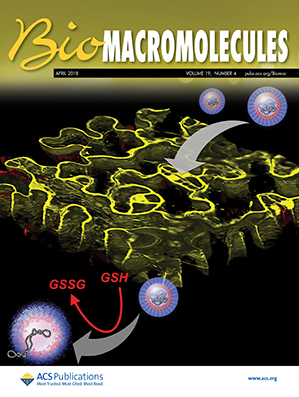氢键和疏水相互作用通过聚合诱导的微相分离增强坚韧和抗膨胀的水凝胶。
IF 5.4
2区 化学
Q1 BIOCHEMISTRY & MOLECULAR BIOLOGY
引用次数: 0
摘要
聚合诱导微相分离策略为设计具有微相分离结构的水凝胶提供了有效途径。采用组氨酸甲基丙烯酰胺与甲基丙烯酸单体共聚制备了一种微相分离水凝胶。聚合过程中发生自发微相分离,由咪唑与羧基之间的强氢键相互作用驱动,由甲基的疏水相互作用稳定。微相分离后的水凝胶力学性能显著提高,刚度达到67 MPa,抗拉强度达到2.2 MPa,韧性达到8.3 MJ/m3,断裂能达到7.0 kJ/m2,且具有较好的耗能能力。这些水凝胶在较宽的pH范围内(pH 3-11)也表现出显著的抗膨胀性能。值得注意的是,微相分离的水凝胶在室温下仍保持玻璃态。此外,水凝胶表现出良好的细胞相容性。本研究为微相分离水凝胶的设计提供了有价值的见解,为其在生物医学工程中的实际应用铺平了道路。本文章由计算机程序翻译,如有差异,请以英文原文为准。
Hydrogen Bond and Hydrophobic Interaction Reinforced Tough and Antiswelling Hydrogels via Polymerization-Induced Microphase Separation
Polymerization-induced microphase separation strategy offers an effective approach for designing hydrogels with microphase-separated structure. In this study, a kind of microphase-separated hydrogels was fabricated by copolymerizing histidine methacrylamide and methacrylic acid monomers. Spontaneous microphase separation occurred during the polymerization process, which was driven by the strong hydrogen bonding interactions between imidazole and carboxyl groups, stabilizing by the hydrophobic interactions of methyl groups. The microphase-separated hydrogels exhibited significantly enhanced mechanical properties, achieving stiffness of 67 MPa, tensile strength of 2.2 MPa, toughness of 8.3 MJ/m3, fracture energy of 7.0 kJ/m2, and superior energy dissipation capabilities. These hydrogels also exhibited remarkable antiswelling performance across a broad pH range (pH 3–11). Notably, the microphase-separated hydrogels remained in a glassy state at room temperature. Moreover, the hydrogels displayed excellent cytocompatibility. This study provides valuable insights into the design of microphase-separated hydrogels, paving the way for their practical applications in biomedical engineering.
- Download: Download high-res image (183KB)
- Download: Download full-size image
求助全文
通过发布文献求助,成功后即可免费获取论文全文。
去求助
来源期刊

Biomacromolecules
化学-高分子科学
CiteScore
10.60
自引率
4.80%
发文量
417
审稿时长
1.6 months
期刊介绍:
Biomacromolecules is a leading forum for the dissemination of cutting-edge research at the interface of polymer science and biology. Submissions to Biomacromolecules should contain strong elements of innovation in terms of macromolecular design, synthesis and characterization, or in the application of polymer materials to biology and medicine.
Topics covered by Biomacromolecules include, but are not exclusively limited to: sustainable polymers, polymers based on natural and renewable resources, degradable polymers, polymer conjugates, polymeric drugs, polymers in biocatalysis, biomacromolecular assembly, biomimetic polymers, polymer-biomineral hybrids, biomimetic-polymer processing, polymer recycling, bioactive polymer surfaces, original polymer design for biomedical applications such as immunotherapy, drug delivery, gene delivery, antimicrobial applications, diagnostic imaging and biosensing, polymers in tissue engineering and regenerative medicine, polymeric scaffolds and hydrogels for cell culture and delivery.
 求助内容:
求助内容: 应助结果提醒方式:
应助结果提醒方式:


